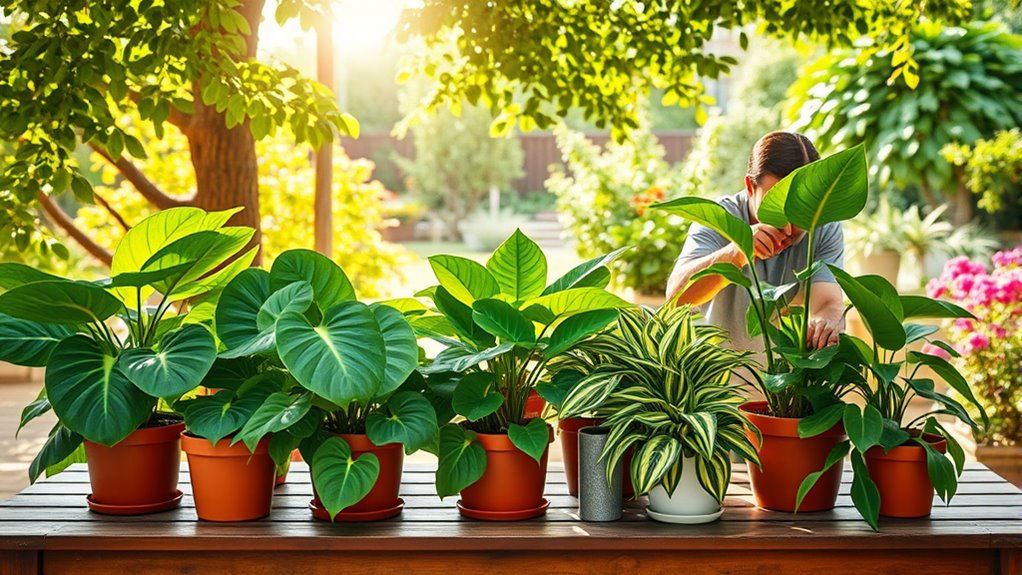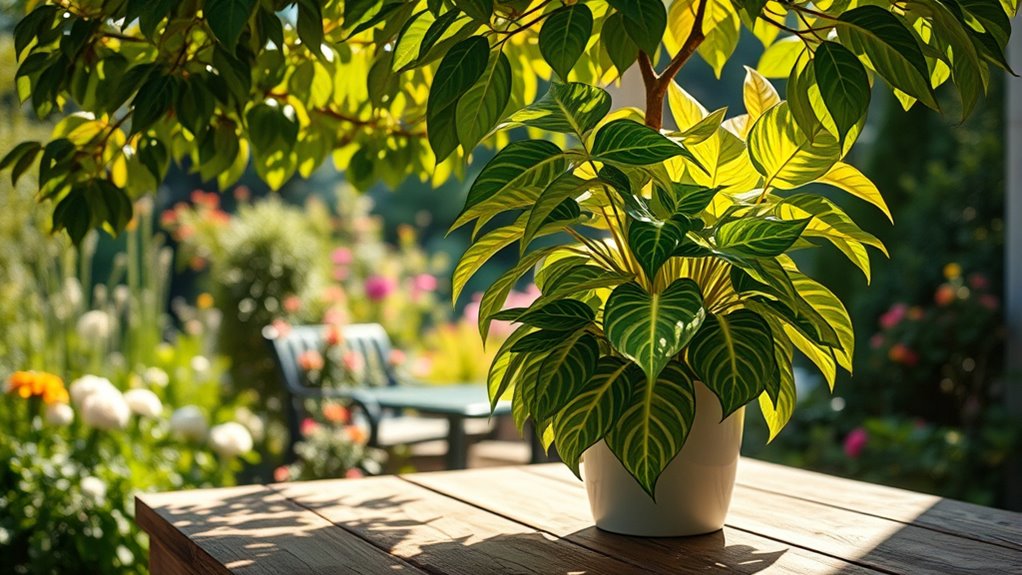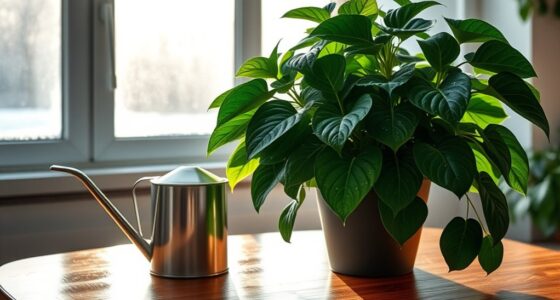To safely acclimate your houseplants to direct summer sun, wait until after the last spring frost and gradually introduce them outdoors. Start by placing them in shaded, sheltered spots for a few hours daily, then slowly increase their exposure to direct sunlight over a week or two. Keep a close eye on watering needs and pests, adjusting care as plants adapt. If you want to guarantee a smooth transition, here’s what you need to know.
Key Takeaways
- Wait until after the last spring frost to ensure outdoor temperatures are reliably warm.
- Gradually introduce plants to direct sunlight over 1-2 weeks, starting with shaded or sheltered spots.
- Increase exposure gradually to prevent leaf scorch, monitoring each plant’s sun tolerance.
- Adjust watering frequency outdoors to maintain soil moisture without overwatering, supporting plant adaptation.
- Inspect plants thoroughly for pests before moving outdoors and monitor regularly to catch issues early.

Have you ever wondered when is the best time to move your houseplants outdoors? Timing is key to guarantee your plants transition smoothly without stress or damage. The ideal moment usually aligns with the end of spring or early summer, once the outdoor temperatures are consistently warm—typically after the last frost date in your area. Moving plants too early can expose them to cold snaps or sudden temperature swings, which may shock or stunt their growth. Waiting until the weather stabilizes helps your plants adjust gradually to their new environment.
The best time to move houseplants outdoors is after the last spring frost when temperatures are reliably warm.
Before you take your plants outside, it’s essential to plan their acclimation process carefully. Start by placing them in a shaded, sheltered spot for a few hours each day, gradually increasing their exposure to direct sunlight over a week or or two. This slow transition prevents leaf scorch and helps them build resilience to the sun’s intensity. Remember, different plants have different sun tolerances, so do some research on each species’ needs. Be mindful of the intensity and duration of sunlight, especially during the hottest part of summer, to prevent sunburn.
Watering schedule plays a crucial role during this transition. As your plants move outdoors, their watering needs may change because of increased exposure to wind, sun, and natural elements. Keep a close eye on the soil moisture and adjust your watering routine accordingly. Usually, outdoor plants require more frequent watering than when they’re indoors, but avoid overwatering, which can lead to root rot. Check the soil regularly, and ensure it’s moist but not soggy. Proper watering not only keeps your plants healthy but also supports their ability to adapt to the new environment. Incorporating HEPA filtration and other air quality improvements indoors can help maintain overall plant health by reducing airborne pollutants that might stress your plants.
Pest prevention is another vital aspect of taking houseplants outdoors. Moving plants outside introduces them to a broader range of insects and pests that may not be present indoors. To minimize risks, inspect each plant thoroughly for any signs of pests before moving them outside. Use gentle, organic pest repellents or neem oil if necessary, and keep an eye on your plants once outdoors. Regular monitoring helps catch infestations early, making pest prevention easier and more effective. Creating a healthy, pest-free environment supports your plants’ growth and keeps them thriving after the move.
Frequently Asked Questions
How Long Should I Keep My Houseplants Outdoors Each Day?
You should start by keeping your houseplants outdoors for about 1-2 hours each day, gradually increasing sunlight exposure. During this time, spray watering helps keep the soil moist, preventing stress from the change. Monitor their response closely—if you notice wilting or leaf burn, reduce exposure. Over a week or two, extend outdoor time gradually, ensuring your plants adapt safely without shock or sunburn.
Are There Specific Plants That Can’t Tolerate Outdoor Conditions?
Your houseplants might be more delicate than you think, like tiny glass sculptures. Some plants, especially frost-sensitive varieties, can’t handle outdoor conditions. Shade-tolerant species might thrive, but others could burn or suffer from harsh sun. Always research your specific plants before exposing them to outdoor elements. If unsure, keep these sensitive varieties indoors or in shaded areas to prevent damage and make sure they stay healthy.
How Do I Protect My Plants From Pests Outdoors?
To protect your plants from pests outdoors, start with pest prevention by regularly inspecting them for signs of trouble. Use natural repellents like neem oil, garlic spray, or insecticidal soap to deter unwanted visitors. Keep your garden tidy, remove debris, and encourage beneficial insects such as ladybugs and lacewings. These steps create a healthy environment and help defend your plants without harmful chemicals, ensuring they thrive in their outdoor setting.
What Signs Indicate My Plant Is Stressed From Outdoor Exposure?
Did you know that up to 60% of indoor plants show stress signs when exposed to outdoor conditions? You’ll notice leaf discoloration, such as yellowing or browning, indicating sunburn or nutrient issues. Wilting symptoms, like drooping leaves, suggest your plant is overwhelmed by the change. Keep an eye out for these signs, and gradually introduce your plant to outdoor conditions to help it adapt without stress.
How Should I Adjust Watering When Moving Plants Outside?
When you move your plants outside, you should adjust your watering frequency based on soil moisture. Check the soil regularly and water only when it feels dry a couple of inches below the surface. Outdoor conditions cause faster evaporation, so you might need to water more often, especially during hot, sunny days. Keep an eye on soil moisture to prevent both overwatering and underwatering, ensuring your plants stay healthy.
Conclusion
By gradually introducing your houseplants to outdoor sunlight, you help them adapt and thrive in their new environment. For example, imagine moving a lush fern from your shady porch to a sunnier spot; with patience, it’ll develop stronger leaves and healthier growth. Remember, start slow and watch how your plants respond. Before long, they’ll be basking in the sun, adding vibrant greenery to your outdoor space—all thanks to your careful acclimation.











